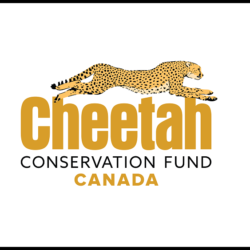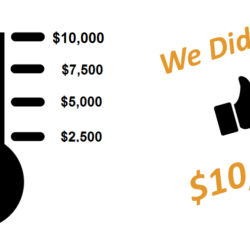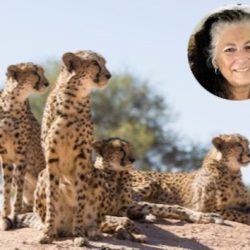Q & A Session with Dr. Laurie Marker and Dr. Bruce Brewer
-

- by Cheetah Conservation Fund Canada March 22, 2015
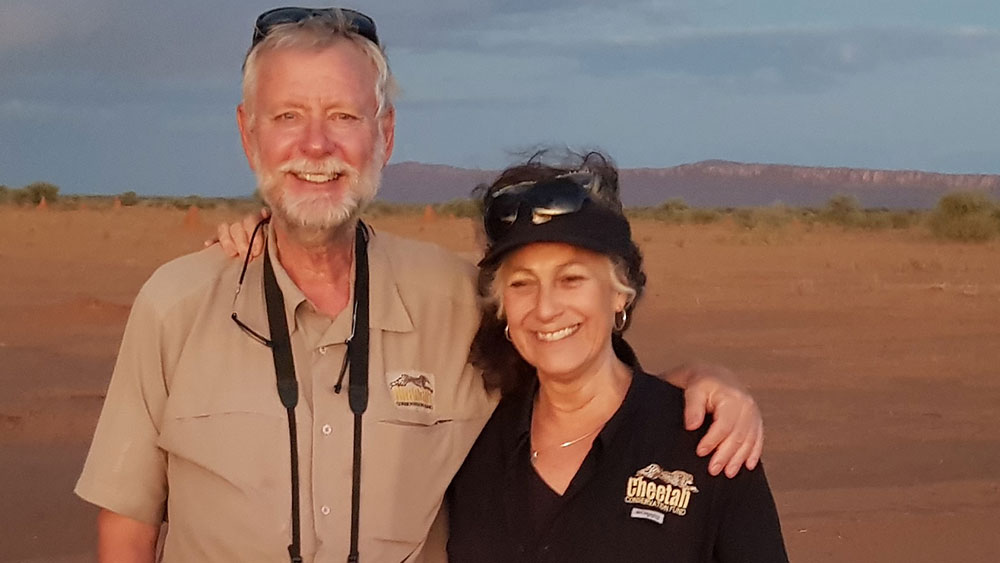
During our recent Annual General Meeting, we were very pleased to have Dr. Laurie Marker and Dr. Bruce Brewer of Cheetah Conservation Fund in Namibia join us on the conference call.
We took the opportunity to reconnect with them and ask about life on the front-line of cheetah conservation.
Our Top 10 Questions:
Question: We know that this is the 25th anniversary for Cheetah Conservation Fund. How many cheetahs have been rehabilitated and returned into the wild?
Answer: (Dr. Marker): Over this period, we have worked on over 900 cheetahs. Well over 600 have been put back into the wild. Of these, most were wild and didn’t need to be rehabilitated in the first place. Right now, we are working on close to 52 cheetahs.
Q: We understand that the rebuilding of the education centre is progressing very well. Can you provide an update for us?
A: (Dr. Bruce Brewer) First, a bit of background. We are rebuilding the education centre after losing the former building due to fire from lightning strikes in October 2013.
We began the rebuilding in 2014. The plan is that the contractors will turn it over to us by the end of February 2015. The new building will not only house the displaced functions – meetings rooms, classrooms but also the gift shop, café and kitchen for visitors – but it will also allow us to add on some other functions, for example, some desperately needed office space.
We will be moving the genetics lab into this larger space; at the same time, the public will be able to view our work through a glass wall, and see the hard science of what we are doing.
This will help get young students enthused about the science role in conservation.
Q: What are the education programs that will be delivered at the Center, in particular, for the young learners and the future farmers? What are some of your new programs? How do these programs benefit the communities?
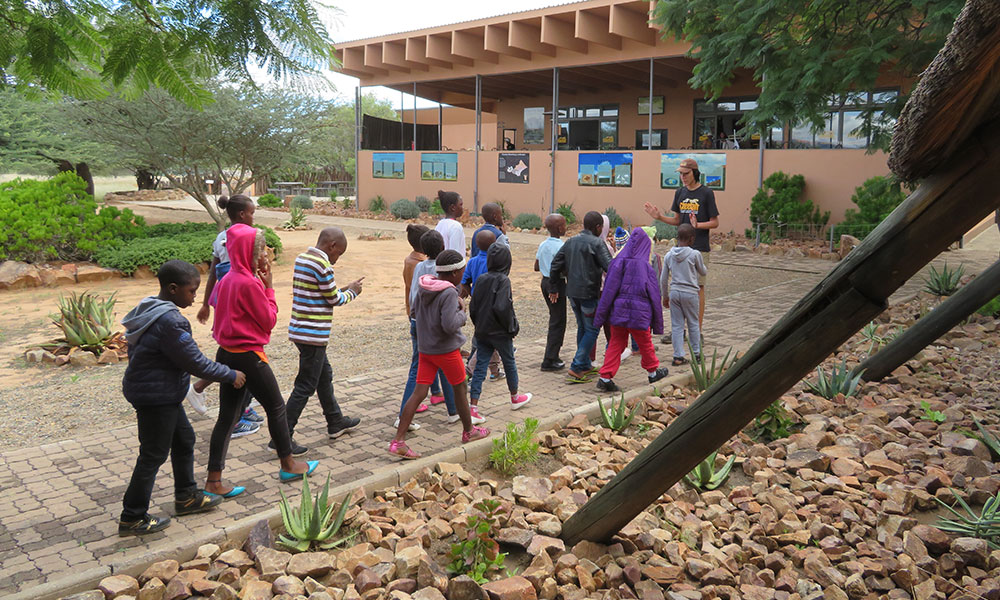
A: (Dr. Marker) This past year, we had about 2000 school children from local schools as well as several hundred rural farmers in our programs. On top of that, we are anticipating between 7000 and 9000 international visitors coming to learn at CCF as well. It has been a challenge this year because we have had no classrooms due to the fire in October 2013, but our new building will be great.
We have some new training courses, Future Farmers is ongoing and we are scaling up in a big way. We are now working in the Hereroland – a communal area on the other side of the Waterberg Plateau (location of CCF). We have an extensive program with school children and the farmers there, and we have been asked to work with the government’s Agriculture arm to help train their technicians and managers and working in the west with farmers to manage human-wildlife issues.
One of the key parts of our education program is our Intern Program. With our new building, we’ll be better able to host that program. This program is open to students at any level – from advanced high school and onwards. There are a variety of disciplines that students are pursuing, amongst our interns. A good number come from vet science, wildlife science and conservation science; there are also other areas. Students can come for 3 weeks to 6 months.
Not quite half are from Namibia and the rest are from other countries around the world. If a student comes with pre-agreed program, we can facilitate ideas from their discussions with advisors, but if not, we work with them when they arrive. We want to make sure it is tailored to individuals’ interests and program needs. Most can get college credit. Projects can include hard data analysis of data we already have, or going out in the field to gather data on animals, or plants, or helping on human-wildlife issues.
Q: Can you share with us some of the global contributions of CCF in advancing the cause of protecting the cheetahs in the wild as well as understanding the biology/genetics that are essential to the cheetah’s survival?
A: (Dr. Marker) We are one of the few molecular genetics labs outside of a major city, and one of a very small group in Africa. That allows us to train students from southern Africa range countries.
We also act as a service lab on genetics for cheetahs, other carnivores and rhinos in Namibia. We contribute to global training – bringing in colleagues and practitioners from across Africa and the Middle East who are addressing issues of human-wildlife conflict (as well as those familiar with predator problems in the Americas).
They spend time with us to learn how to look at common approaches for bio-medical approaches to captured animals, how to take samples, how to store these samples, how to conduct a census, radio and satellite telemetry.
We think that the training of colleagues, as well as networking and sharing, are among the greatest contributions to conservation science.
Q: Please tell us more about the Asiatic Cheetah and how they differ from the cheetahs in Africa. How optimistic are you about this sub-species of cheetah being restored? What kind of support are you seeing in the Middle East?
A: (Dr. Marker) Over the last 12 years, there has been support of the Iranian (or Asiatic) cheetah. We have been working actively in Iran to undertake training with their biologists. As well, people at high levels of government have been to CCF.
The number of cheetahs in Iran is still at 70 animals, so they are still critically endangered. In Iran, there is a Persian Wildlife Society, which helps support changes in policy. So, we are fairly optimistic that we have been able to change the course for these cheetah through strategic planning and study.
It’s important to note that the only Asiatic cheetahs in existence are are in Iran. We have also been asked to consult on reintroduction of cheetah into other ranges like Kazakhstan.
Genetically, the Asiatic cheetah is similar to African cheetahs. In general, when species look different, it is probably because they branched off genetically close to 10,000 years ago. These animals would have branched off more recently and, as a result, they look quite similar. In fact, the five sub-species of cheetah all look quite similar.
Q: While illegal trade is a major problem for cheetahs, can you comment on the ‘legal’ trade in cheetahs, those that are in zoos or other captive situations? What can other countries learn from Namibia’s approach to conservation?
A: (Dr. Marker) There is really no legal trade in cheetahs. Zoos that are accredited can move cheetahs within their countries, but if they are to be moved from one country to another, it needs to go through CITES. Cheetahs are Appendix 1 animals and there is no trade allowed. If you want to move cheetahs from Canada to the US or to Europe, for example, extensive paperwork must be done to demonstrate why this is being done.
For captive breeding purposes, zoological associations and their species survival programs have been able to show the importance of sharing genetic diversity within captive populations. Managers of programs use computer program to determine which cheetahs may be recommended to go for breeding to maximize genetic diversity. These programs are important in case anything happens in the world to affect the wild populations. They are also a way to educate the public and a way for zoos to do research.
It is our opinion – and a strong one – that animals in captivity should not be sourced from the wild. Currently, the captive population is about 1500, in about 200 zoos in 65 countries. I manage the international studbook and work with captive program managers and ensure that genetic diversity is maintained.
Q: During your visit to Vancouver, you met with Canadian mining firms, some of which are providing support to CCF. What are the benefits in having private sector support, and how do these partnerships benefit mining companies?
A: (Dr. Marker) In Namibia, there are a lot of natural resources, and mining companies know that they are using up communal lands. But they are also trying to be conservationists around their sites.
Cheetahs need huge ranges. The lands around mines can be rehabilitated so that the companies leave a smaller footprint.
Mining companies can be great partners in managing large landscapes that provide space for wildlife and grasslands. As well, these Namibian-based mining companies are working in other range countries.
There could be additional opportunities for mining companies throughout Africa, for example, in ecotourism and its economic benefits. These are part of longer-term business plans that we are working on with these companies.
CCF was pleased to host some of the management of B2Gold and their guests during a recent visit to the CCF main campus. B2Gold operate the nearby Otjikoto gold mine, which came into production late last year and is an important addition to the Namibian economy. Mark Dawe, the MD of the Otjikoto mine, is a Director of CCF Namibia.
B2Gold has been a wonderful donor to CCF and our ecology staff assist in biodiversity research on the mine’s set-aside ecological reserve.
The most recent addition to our resident cheetahs, B2, is named after B2Gold.
Q: Can you provide us with an update on new developments with the Livestock Guarding Dog Program, including your expansion to other countries?

A: (Dr. Marker) We started the program just over 20 years ago and, in that time, we’ve bred and placed 600 dogs. This year, we had a ‘bumper crop’ with just over 50 puppies, and eight breeding females for next year.
Of course, growing the program is a “numbers game”. Having breeding dogs means that they are taken away from the herds, so people don’t necessarily want to breed.
We have also committed to the Anatolian and Kangal dog people that we will continue to maximize the gene pool and ensure that we are taking very good care of the dogs.
Most of the dogs that go out are sterilized beforehand. Our program is labour intensive, as we ensure regular checkups. One value of this is that it gets us out to the farmers and their communities, so that we’re aware of management issues and it also helps us deal with human-wildlife issues.
We are planning for about 60 dogs in 2015, and to prepare, we have doubled the size of breeding pens this year. We always have a waiting list of about 100 people, and we work closely with these people so they won’t get frustrated. We try to ensure that we send dogs where there is the most urgent need to address human-wildlife issues.
In addition to placing dogs with farmers in Namibia, last year, we also placed 6 dogs in Tanzania. They were placed in Ruaha, which is a national park, and in a very remote game reserve in central Tanzania. There are four different tribal groups there and significant conflict with lions, cheetahs, leopards, and hyenas.
We are very excited about this and are working closer with Amy Dickman who was previously a PhD research assistant at CCF. She is one of the people I entrust to be doing this in the right way, and we are very confident about the approach she is leading. We have now given them a breeding female and are planning to find a breeding male for their programs.
Q: Can you talk about the skills training that you are providing for women and for young people? How do you see this changing/evolving in the coming decade?
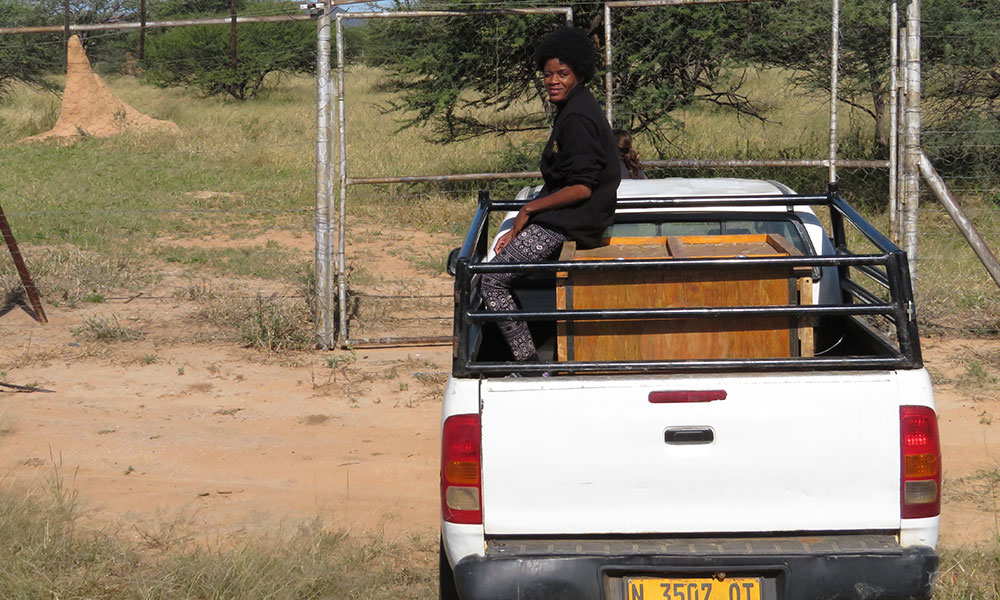
A: (Dr. Brewer): Of course, we also need to include the young men! The majority of young people enrolled in intern programs are women; this includes our creamery, where we have food science students from the University of Namibia, and hospitality students from a couple of programs in tourism. And we have long ternm students involved in all sorts of operations.
We find that not that many Namibian students are interested in animal care, but we hope to see this changing. It is a continual effort to get more Namibian students into field biology and husbandry.
Interns from both genders go through our genetics lab, and up to the master’s level.
We are also doing crafts training for those people – mostly mature — who are our close neighbours and those living in the communal lands.
Q: In Canada, we only have cheetah in zoos or safari parks. What’s the most compelling reason for people in Canada to understand how important it is to save the cheetah?
A: (Dr. Marker) It is always hard when you are not on ground with the animals in Africa. But it is a global world. It is important for people to understand the value of the cheetah and other predators in ecosystems. As part of the mega-fauna, the cheetah will bring in eco-tourism resources and help the country.
A: (Dr. Brewer) Africa does have some significant problems with a growing population and a lack of development and accompanying resources. In some instances, communities and people cannot afford to prioritize the conservation of species and thus, it is important that the global community needs to pitch in and reach out.
Related Reading
-
September 1, 2021
Cheetah Fit Challenge 2021: The Results Are In! -
October 15, 2020
CCF updates from Dr. Laurie Marker (Part Two)
